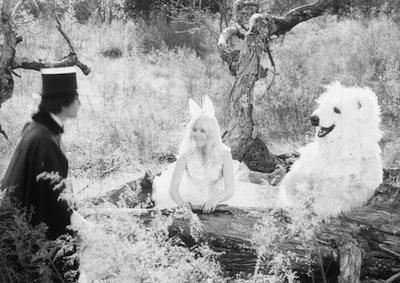Written, directed, and self-financed by Juleen Compton, The Plastic Dome of Norma Jean is the story of a clairvoyant teenage girl, Norma Jean (Sharon Henesy), taken advantage of by a boy band, fashioned after The Beatles, determined to exploit the young woman's powers as part of a hoax revival.
Filmed in the Ozarks with a cast of young, unknown actors (a 25-year-old Sam Waterston co-stars in his first film appearance), the picture's opening title sequence—the two young leads walking through a bucolic setting with Michel Legrand's sentimental score—suggests a tender tale about a pair of young companions. However, the movie quickly takes an unusual turn when Norma Jean and her friend Vance (Robert Gentry) pick up an enormous plastic dome they've ordered. The narrative never reveals the structure's origins or purpose, but the image of the looming, yet magical two-story high edifice, provides an engaging and enigmatic set piece for the rest of the movie.
Stylistically accomplished, the movie is an impressive example of American independent feature filmmaking during the mid-1960s and an uncommon portrayal, for the time, of female agency.
During the 1970s, Compton moved to Los Angeles in hopes of directing features in Hollywood. In 1974 she participated in the inaugural year of the American Film Institute's Directing Workshop for Women; and wrote scripts for television movies. Frustrated with Hollywood's sexist hiring practices, after completing her third film, the independently produced Western Buckeye and Blue (1988), Compton returned to New York City during the 1990s to run her successful off-Broadway theater company, the Century Center for the Performing Arts. —Maya Montañez Smukler
35mm, b/w, 82 min. Director: Juleen Compton. Production: Compton Films. Producer: Juleen Compton, Stuart Murphy. Screenwriter: Juleen Compton. Cinematographer: Roger Barlow. Editor: Budd Hamilton, Stuart Murphy. Music: Michel Legrand. Cast: Sharon Henesy, Robert Gentry, Marco St. John, Sam Waterson, Skip Hinnant, Arthur Hughes.
Restored from the 35mm original picture negative and 35mm original track negative. Laboratory services by The Stanford Theatre Film Laboratory. Sound services by Audio Mechanics, DJ Audio, Inc., Simon Daniel Sound.






 Mobile Navigation
Mobile Navigation

